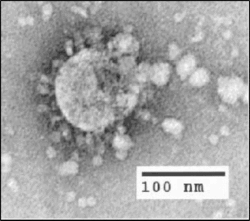Difference between revisions of "SARS"
m (typo) |
(small expand, de-dramatize) |
||
| Line 2: | Line 2: | ||
|wikipedia=https://en.wikipedia.org/wiki/Severe_acute_respiratory_syndrome | |wikipedia=https://en.wikipedia.org/wiki/Severe_acute_respiratory_syndrome | ||
|image=SARS_virion.gif | |image=SARS_virion.gif | ||
| − | |constitutes=virus | + | |constitutes=virus |
|description=A corona virus first that killed at least 774 people in 2003, and has since broken out of laboratories 6 times. | |description=A corona virus first that killed at least 774 people in 2003, and has since broken out of laboratories 6 times. | ||
| − | }}'''SARS''' | + | }} |
| + | '''Severe acute respiratory syndrome''' ('''SARS''') was a rare viral respiratory disease, with indistinguishable symptoms to influenza. The handling and presentation of the situation showed several signs with the later handling of the 2009 Swine Flu and 2020 [[Covid-19]] declared pandemics. | ||
| + | |||
| + | ==Spread and Danger== | ||
| + | At the end of the epidemic in June 2003, the incidence was 8,422 cases with a case fatality rate (CFR) of 11%. This number is insignificant compared to ordinary flu each year, with between three and five million cases each year, resulting in 290,000 to 650,000 deaths. | ||
| + | |||
| + | Despite the big drama around it, the [[pandemic]] fizzled out, allegedly contained after its first emergence in 2003, but with subsequent escapes from labs in [[Asia]]. | ||
==Origins== | ==Origins== | ||
| + | The Chinese researcher, [[Zhong Nanshan]], who “discovered the SARS virus” in 2003, was at the forefront of pronouncements about the “new coronavirus” [[Covid-19] that led to surch drastic [[Covid-19/lockdown|lockdowns]]. | ||
| + | |||
In late 2017, Chinese scientists traced the virus through the intermediary of civets to cave-dwelling horseshoe bats in [[Yunnan]] province.<ref>https://www.theguardian.com/world/2017/dec/10/sars-virus-bats-china-severe-acute-respiratory-syndrome</ref> | In late 2017, Chinese scientists traced the virus through the intermediary of civets to cave-dwelling horseshoe bats in [[Yunnan]] province.<ref>https://www.theguardian.com/world/2017/dec/10/sars-virus-bats-china-severe-acute-respiratory-syndrome</ref> | ||
| + | |||
| + | Only two days after the virus was identified, virologists [[Christian Drosten]] and [[Stephan Günther]] from the German [[Bernhard Nocht Institute]] were the first to develop a diagnostic test that is now used worldwide.<ref>https://www.bnitm.de/aktuelles/mitteilungen/113-virologen-des-tropeninstituts-erhalten-preis-der-werner-otto-stiftung/</ref> | ||
==Control== | ==Control== | ||
| − | SARS is most infectious in severely ill patients, which usually occurs during the second week of the illness. This delayed infectious period meant that quarantine was highly effective; people who were isolated before day five of their illness rarely transmitted the disease to others.<ref>https://hdl.handle.net/10665%2F70863</ref> | + | SARS produces flu-like symptoms and may include fever, muscle pain, lethargy, cough, sore throat, and other nonspecific symptoms. SARS is most infectious in severely ill patients, which usually occurs during the second week of the illness. This delayed infectious period meant that quarantine was highly effective; people who were isolated before day five of their illness rarely transmitted the disease to others.<ref>https://hdl.handle.net/10665%2F70863</ref> |
==Outbreaks== | ==Outbreaks== | ||
| − | + | During November [[2002]] through July [[2003]], a total of 8,098 people worldwide became sick with severe acute respiratory syndrome [SARS] that was accompanied by either pneumonia or respiratory distress syndrome (probable cases), according to the [[World Health Organization]] (WHO). Of these, 774 died. By late July [[2003]], no new cases were being reported, and WHO declared the global outbreak to be over.<ref>https://www.cdc.gov/sars/about/faq.html#global</ref> | |
| + | [[image:Sars1.png|thumbnail|300px|right]] | ||
Subsequently, it has escaped from laboratories at least 6 times, once in Singapore, once in Taiwan, and four times from a single laboratory in [[Beijing]].<ref>https://thebulletin.org/2014/03/threatened-pandemics-and-laboratory-escapes-self-fulfilling-prophecies/</ref> | Subsequently, it has escaped from laboratories at least 6 times, once in Singapore, once in Taiwan, and four times from a single laboratory in [[Beijing]].<ref>https://thebulletin.org/2014/03/threatened-pandemics-and-laboratory-escapes-self-fulfilling-prophecies/</ref> | ||
Revision as of 11:31, 28 January 2021
(virus) | |
|---|---|
 | |
| Interest of | • GreatGameIndia • Zhengli Shi |
| A corona virus first that killed at least 774 people in 2003, and has since broken out of laboratories 6 times. | |
Severe acute respiratory syndrome (SARS) was a rare viral respiratory disease, with indistinguishable symptoms to influenza. The handling and presentation of the situation showed several signs with the later handling of the 2009 Swine Flu and 2020 Covid-19 declared pandemics.
Contents
Spread and Danger
At the end of the epidemic in June 2003, the incidence was 8,422 cases with a case fatality rate (CFR) of 11%. This number is insignificant compared to ordinary flu each year, with between three and five million cases each year, resulting in 290,000 to 650,000 deaths.
Despite the big drama around it, the pandemic fizzled out, allegedly contained after its first emergence in 2003, but with subsequent escapes from labs in Asia.
Origins
The Chinese researcher, Zhong Nanshan, who “discovered the SARS virus” in 2003, was at the forefront of pronouncements about the “new coronavirus” [[Covid-19] that led to surch drastic lockdowns.
In late 2017, Chinese scientists traced the virus through the intermediary of civets to cave-dwelling horseshoe bats in Yunnan province.[1]
Only two days after the virus was identified, virologists Christian Drosten and Stephan Günther from the German Bernhard Nocht Institute were the first to develop a diagnostic test that is now used worldwide.[2]
Control
SARS produces flu-like symptoms and may include fever, muscle pain, lethargy, cough, sore throat, and other nonspecific symptoms. SARS is most infectious in severely ill patients, which usually occurs during the second week of the illness. This delayed infectious period meant that quarantine was highly effective; people who were isolated before day five of their illness rarely transmitted the disease to others.[3]
Outbreaks
During November 2002 through July 2003, a total of 8,098 people worldwide became sick with severe acute respiratory syndrome [SARS] that was accompanied by either pneumonia or respiratory distress syndrome (probable cases), according to the World Health Organization (WHO). Of these, 774 died. By late July 2003, no new cases were being reported, and WHO declared the global outbreak to be over.[4]
Subsequently, it has escaped from laboratories at least 6 times, once in Singapore, once in Taiwan, and four times from a single laboratory in Beijing.[5]
Related Quotation
| Page | Quote | Author | Date |
|---|---|---|---|
| MERS | “the method is so sensitive it can identify a single genetic molecule. If such a pathogen for example were to be found lying dormant in a nurse all day in the mucous membrane of her nose, she would be identified as a MERS case without being ill, or even being aware of it. Where previously only critically ill patients were recorded in the statistics, those with very mild symptoms and even completely healthy people were now included. This what explains the surge in cases in Saudi Arabia. This is further exacerbated by the sensational reporting of the local media.” | Christian Drosten | 2014 |
Related Document
| Title | Type | Publication date | Author(s) | Description |
|---|---|---|---|---|
| Document:Logistical and Technical Exploration into the Origins of the COVID-19 virus | report | 31 January 2020 | Jonathan Jay Couey | Report of a thorough investigation into the origins of the virus that caused the pandemic. Whilst the author is circumspect, the evidence presented points clearly to the virus being the product of laboratory engineering. |
References
- ↑ https://www.theguardian.com/world/2017/dec/10/sars-virus-bats-china-severe-acute-respiratory-syndrome
- ↑ https://www.bnitm.de/aktuelles/mitteilungen/113-virologen-des-tropeninstituts-erhalten-preis-der-werner-otto-stiftung/
- ↑ https://hdl.handle.net/10665%2F70863
- ↑ https://www.cdc.gov/sars/about/faq.html#global
- ↑ https://thebulletin.org/2014/03/threatened-pandemics-and-laboratory-escapes-self-fulfilling-prophecies/
